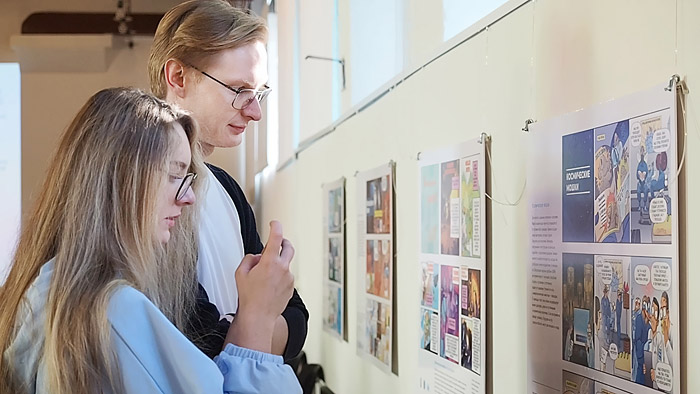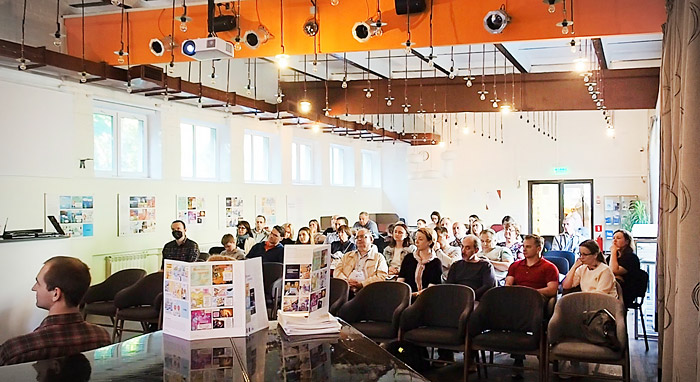
Electronic english version since 2022 |
The newspaper was founded in November 1957
| |
Science in comic strips:
an easy way to explain complicated things
On 17 June, the exhibition "Science in comic strips: an easy way to explain complicated things" - a joint project of the Dzhelepov Laboratory of Nuclear Problems and the Komikadze group was opened at the JINR Universal Public Library "Blokhinka". Head of the DLNP Group of Scientific Communications (GSC DLNP) Elena Dubovik shared with the audience of the library reading room the details of the DLNP experiment on popular science visualization of their research. Five comic strips presented at the meeting are dedicated to research carried out by the DLNP Sector of Molecular Genetics of the Cell under the guidance of Candidate of Biological Sciences Elena Kravchenko.
Elena Dubovik spoke about what science comic strips were and how they could be used to talk about the complex and extremely exciting research carried out by biologists at DLNP JINR. Mikhail Zarubin, a junior researcher, shared his impressions about the trip to the Baksan Neutrino Observatory of INR of RAS, about sampling the unused remote parts of the tunnel and presented some of the results of his research work. Bioinformatician Kirill Tarasov spoke about the reconstruction of individual genomes from Baksan samples and also about the discovery of new bacterium species. Lina Aleksyunayte, a scriptwriter of the Komikadze group, recreated the process of preparing a comic strip script and gave examples of fruitful collaboration with scientists.

Komikadze is an association of scriptwriters, artists, illustrators and popularizers. In 2018, the book "For Certain" - the first collection of comic strips in Russia about current scientific research with famous scientists as characters was published. Since then, the group has been educating and promoting brands using comic strips, pictures and illustrations. Skoltech, Moscow State University, the Higher School of Economics, the Russian Movement of Schoolchildren, Laba.Media, Bookmate and other carriers of equally well-known brands are among the Komikadze's partners.
We asked Elena Dubovik to comment on the content of this meeting. Here's what we heard from her:
"How to talk about science in such a way that it becomes comprehensible and interesting? Especially in our age of information redundancy, when the brain tries its best to protect itself from unnecessary details, when network users have stopped reading long texts, but only look at them diagonally.
Here the scientific metaphor comes to the aid of the popularizer. It allows to move from complex formulas and concepts to a visual image. The scientific metaphor found its vivid embodiment in the format of a scientific comic strip.
Despite the fact that this format of comic strips widely develops around the world, it still meets with rejection from part of the scientific community that considers this genre frivolous and superficial. This is by no means the case.
A whole team works on the scientific comic strip: scientists who correctly talk about the essence of scientific research; scriptwriters who come up with an exciting story; artists who embody all this in a bright and accurate drawing. As a result, an image is created that is interesting and understandable to both an adult and a child.
Creating cartoon stories about science is one of the promising options for scientific popularization that is very popular today in many countries due to the combination of text with visual images. A comic strip, a genre at the intersection of literature and graphics, corresponds to the rhythm of the life of modern society. Every day a person is faced with a large flow of information and there is a need to present the material as concisely, capaciously and brightly as possible. In this sense, it is the comic strip that satisfies such requests.
How? Participants of our meeting spoke about it in some detail. Scientific correctness is tracked thanks to the well-coordinated work of the whole team: a scientist, a scriptwriter and an artist. The scientist explains the essence of the research. The scriptwriter comes up with drama and metaphors. The artist draws according to a detailed script, where all the details are spelled out, firstly, the sketch of the storyboard, and then the comic strip itself.

All of us who came to meet our readers are convinced that science is an inexhaustible source of stories and plots. But the abundance of terminology can unnecessarily complicate the narrative of a scientific popularizer. This is where comic strips can help: in a lightly entertaining manner, they draw attention to different research areas and help to delve into the essence of experiments that are being implemented. I hope that this conviction will pass on to our readers."
Evgeny MOLCHANOV visited the opening of the exhibition